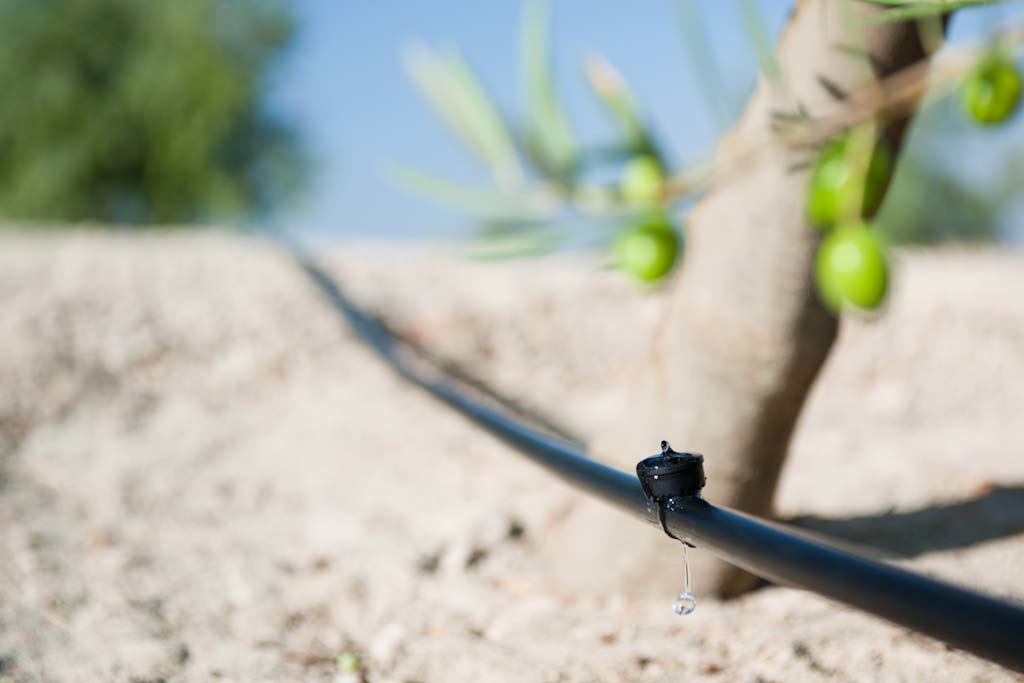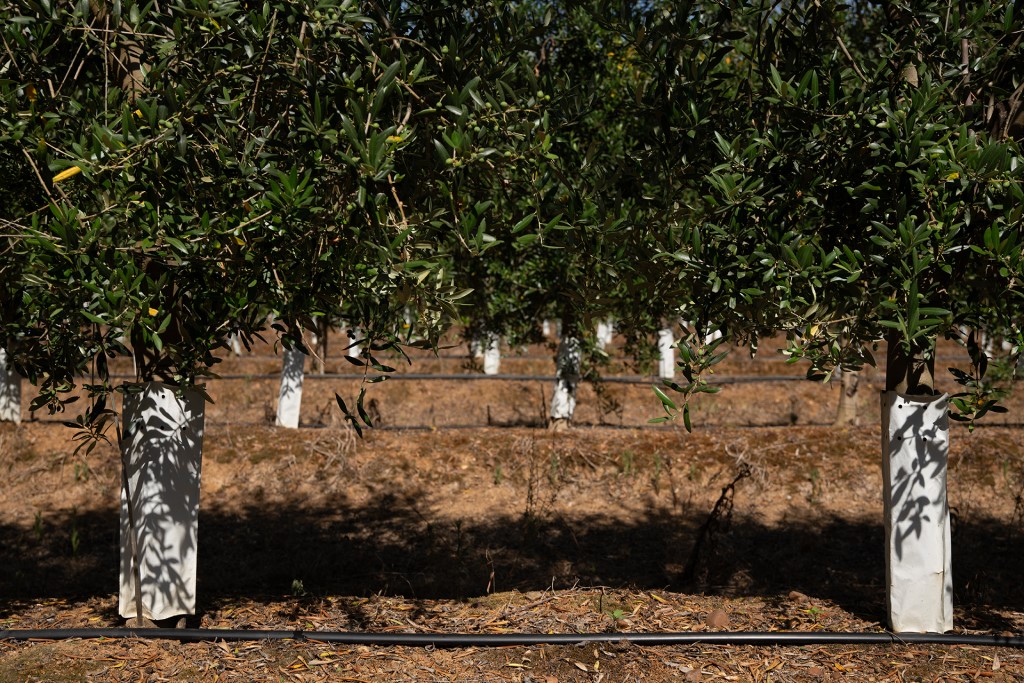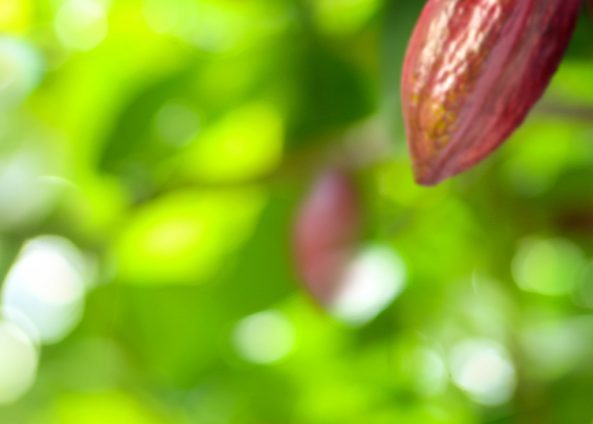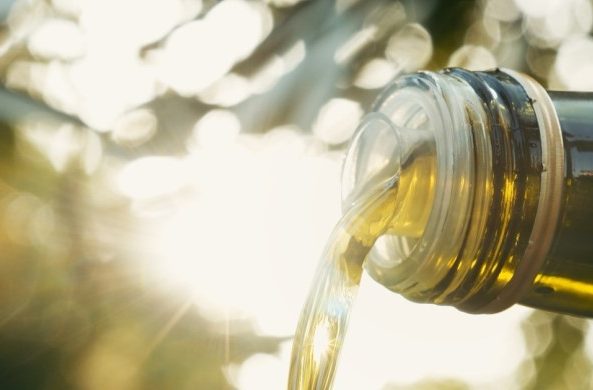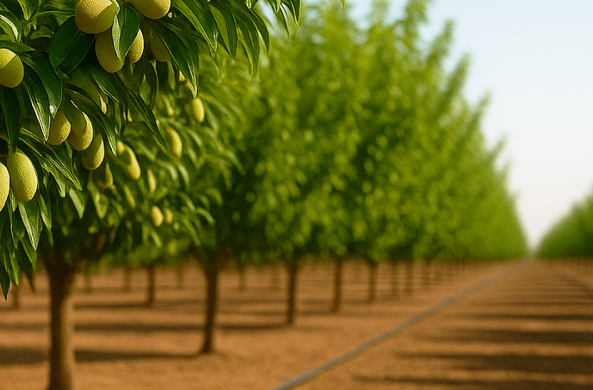
The Unseen Hand: How Irrigation Management Shapes Olive Oil Quality and Taste
By Adolfo Levin, Chief Agronomist, Rivulis
The golden liquid we drizzle over our salads, the heart of the Mediterranean diet – olive oil – owes its exquisite flavor and health benefits to a complex interplay of factors, from olive variety and terroir to harvesting techniques and processing. However, one often underestimated yet crucial element is irrigation management. Precisely controlled watering can significantly impact the quality and taste of the final olive oil, primarily through its influence on the fruit’s water content at pressing.
The water content within the olive fruit directly affects the oil extraction process and the resulting oil’s composition. Over-irrigated olives tend to yield more oil, but this often comes at the cost of quality. Excess water dilutes the concentration of valuable compounds like polyphenols, the potent antioxidants responsible for the oil’s characteristic peppery notes and health-promoting properties. This dilution can lead to a blander oil with a shorter shelf life and reduced nutritional value. Furthermore, when fruits with high water content arrive at the pressing plant, a portion of the water-soluble compounds, including some valuable phenols, are inevitably lost to the wastewater during the processing. This further diminishes the potential polyphenol content of the final oil.
Conversely, under-irrigated trees can produce smaller fruits with lower oil yields. While the concentration of polyphenols might be higher in these olives, extreme water stress can negatively impact the overall health of the tree and potentially lead to off-flavors in the oil.
The sweet spot lies in carefully managing irrigation to ensure optimal fruit hydration levels throughout the growing season, particularly in the critical period leading up to harvest. This involves understanding the specific water needs of the olive variety, the soil type, and the prevailing weather conditions. Implementing precision irrigation techniques, guided by soil moisture sensors, weather data, and even plant-based sensors, allows growers to deliver the right amount of water at the right time.
Proper irrigation management not only influences polyphenol content and contributes to potential losses during processing but also plays a role in the oil’s acidity. High acidity, measured as free fatty acids, is an indicator of oil degradation and poor quality. While factors like fruit damage and delayed processing are primary contributors to high acidity, excessive water uptake close to harvest can potentially increase the fruit’s susceptibility to bruising and fermentation, indirectly leading to higher acidity levels in the extracted oil.
Ultimately, meticulous irrigation management is a cornerstone of producing high-quality extra virgin olive oil with desirable flavor profiles, robust polyphenol content, and low acidity. It’s the unseen hand that guides the olive fruit to its optimal state before pressing, ensuring that the liquid gold we savour is not only delicious but also packed with health benefits.
Classification of Olive Oils According to Main Parameters
| Category | Free Acidity (% by weight) | Peroxide Value (meq O₂/kg) | UV Absorption (K232) | UV Absorption (K270) | Delta-K | Polyphenols (mg/kg) | Organoleptic Characteristics |
| Extra Virgin Olive Oil | ≤ 0.8 | ≤ 20 | ≤ 2.50 | ≤ 0.22 | ≤ 0.01 | Typically ≥ 100 | Fruity, bitter, and/or pungent attributes present. No defects. |
| Virgin Olive Oil | ≤ 2.0 | ≤ 20 | ≤ 2.60 | ≤ 0.25 | ≤ 0.01 | Varies, generally lower than EVOO | Fruity attributes present, may have some minor defects. |
| Lampante Olive Oil | > 2.0 | > 20 | > 2.60 | > 0.25 | > 0.01 | Generally low | Undesirable flavors and odors; not fit for direct consumption. |
| Refined Olive Oil | ≤ 0.3 | ≤ 5 | ≤ 1.10 | ≤ 0.90 | ≤ 0.16 | Very low | Bland, neutral flavor due to the refining process. |
| Olive Oil (Blended) | ≤ 1.0 | ≤ 15 | ≤ 2.50 | ≤ 0.22 | ≤ 0.01 | Varies, depending on blend | A blend of refined olive oil and virgin/extra virgin olive oil; flavor depends on the proportion. |
Classification of Main Olive Oil Varieties According to Taste, Phenols, and Food Suitability
| Category | Taste Profile | Phenols Content | Food Suitability | Examples of Varieties (Origin) |
| Robust & Peppery | Intense bitterness, strong peppery finish | High | Drizzling over grilled meats, hearty stews, bitter greens, bruschetta | Coratina (Italy), Picual (Spain), Koroneiki (Greece) |
| Medium & Fruity | Balanced bitterness and pungency, green fruit notes | Medium | Salads, pasta dishes, roasted vegetables, dipping bread | Arbequina (Spain), Frantoio (Italy), Leccino (Italy) |
| Mild & Buttery | Smooth, delicate, buttery or sweet notes | Low | Seafood, delicate salads, baking, mayonnaise | Hojiblanca (Spain), Kalamata (Greece), Taggiasca (Italy) |
| High Phenolic (Intense) | Very bitter and pungent, often with grassy notes |
Very High |
Consumed for health benefits, drizzled sparingly over robust dishes | Certain early harvest Picual or Koroneiki (Spain, Greece) |
Read more about Olives and Rivulis solutions, here:
https://www.rivulis.com/crop/olives/


